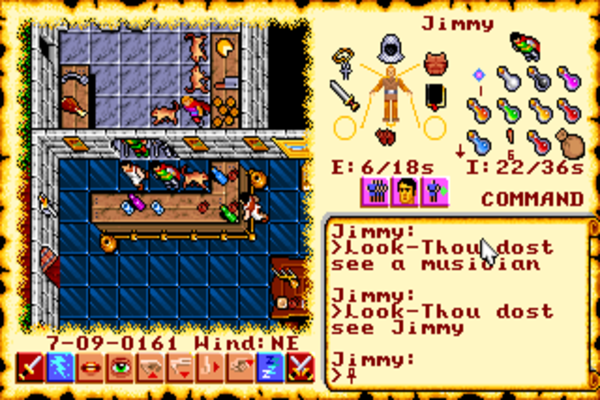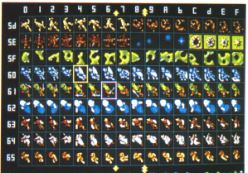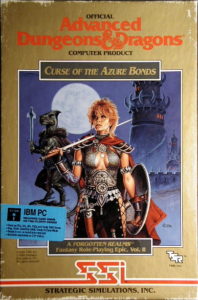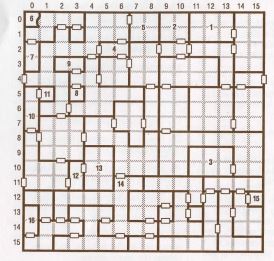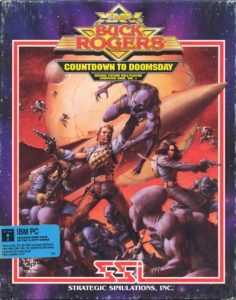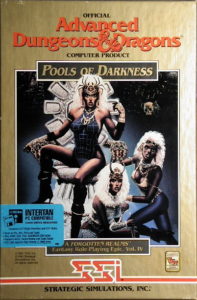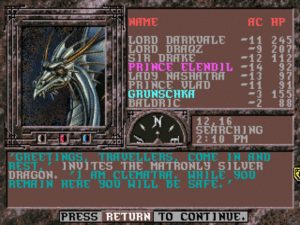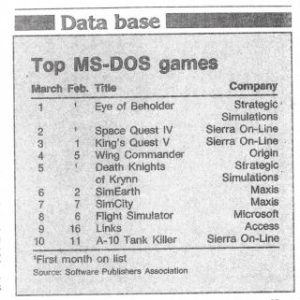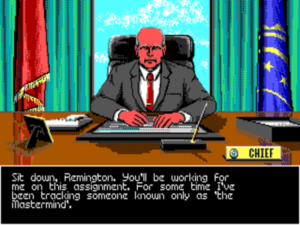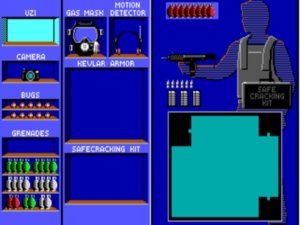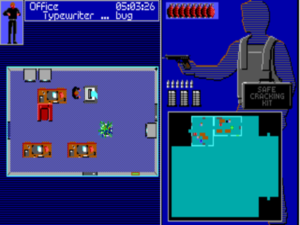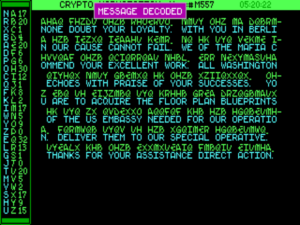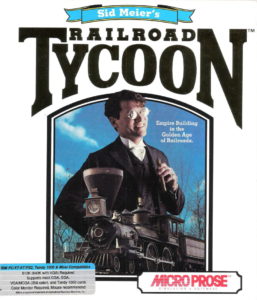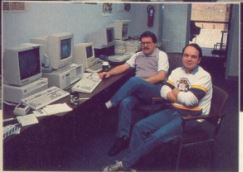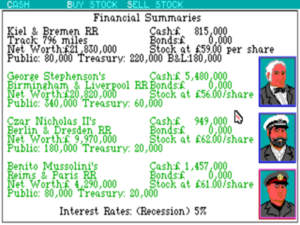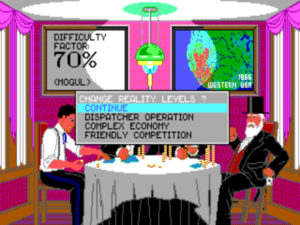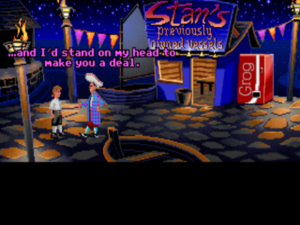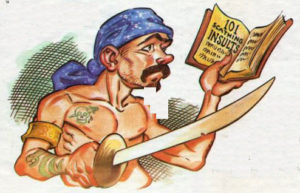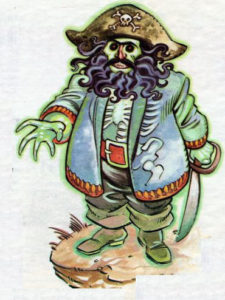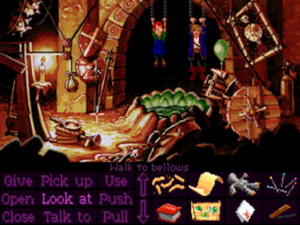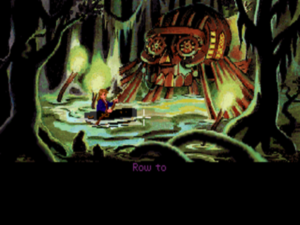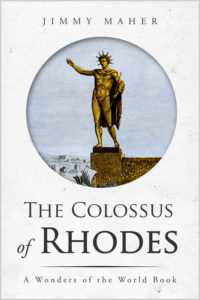After Richard Garriott and his colleagues at Origin Systems finished each Ultima game — after the manic final crunch of polishing and testing, after the release party, after the triumphant show appearances and interviews in full Lord British regalia — there must always arise the daunting question of what to do next. Garriott had set a higher standard for the series than that of any of its competitors almost from the very beginning, when he’d publicly declared that no Ultima would ever reuse the engine of its predecessor, that each new entry in the series would represent a significant technological leap over what had come before. And just to add to that pressure, starting with Ultima IV he’d begun challenging himself to make each new Ultima a major thematic statement that also built on what had come before. Both of these bars became harder and harder to meet as the series advanced.
As if that didn’t present enough of a burden, each individual entry in the series came with its own unique psychological hurdles for Garriott to overcome. For example, by the time he started thinking about what Ultima V should be he’d reached the limits of what a single talented young man like himself could design, program, write, and draw all by himself on his trusty Apple II. It had taken him almost a year — a rather uncomfortable year for his brother Robert and the rest of Origin’s management — to accept that reality and to begin to work in earnest on Ultima V with a team of others.
The challenge Garriott faced after finishing and releasing that game in March of 1988 was in its way even more emotionally fraught: the challenge of accepting that, just as he’d reached the limits of what he could do alone on the Apple II a couple of years ago, he’d now reached the limits of what any number of people could do on Steve Wozniak’s humble little 8-bit creation. Ultima V still stands today as one of the most ambitious things anyone has ever done on an Apple II; it was hard at the time and remains hard today to imagine how Origin could possibly push the machine much further. Yet that wasn’t even the biggest problem associated with sticking with the platform; the biggest problem could be seen on each monthly sales report, which showed the Apple II’s numbers falling off even faster than those of the Commodore 64, the only other viable 8-bit computer remaining in the American market.
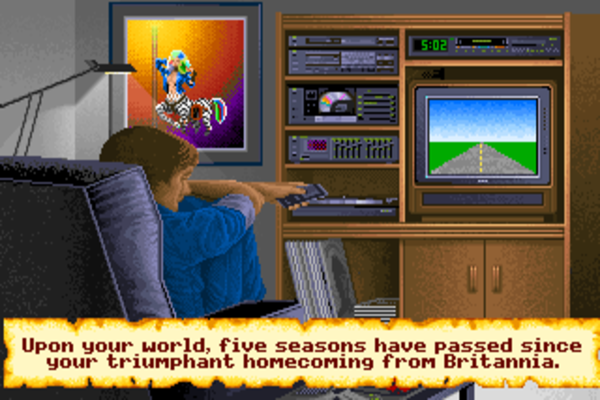
After serving as the main programmer on Ultima V, John Miles’s only major contribution to Ultima VI was the opening sequence. The creepy poster of a pole-dancing centaur hanging on the Avatar’s wall back on Earth has provoked much comment over the years…
Garriott was hardly alone at Origin in feeling hugely loyal to the Apple II, the only microcomputer he’d ever programmed. While most game developers in those days ported their titles to many platforms, almost all had one which they favored. Just as Epyx knew the Commodore 64 better than anyone else, Sierra had placed their bets on MS-DOS, and Cinemaware was all about the Commodore Amiga, Origin was an Apple II shop through and through. Of the eleven games they’d released from their founding in 1983 through to the end of 1988, all but one had been born and raised on an Apple II.
Reports vary on how long and hard Origin tried to make Ultima VI work on the Apple II. Richard Garriott, who does enjoy a dramatic story even more than most of us, has claimed that Origin wound up scrapping nine or even twelve full months of work; John Miles, who had done the bulk of the programming for Ultima V and was originally slated to fill the same role for the sequel, estimated to me that “we probably spent a few months on editors and other utilities before we came to our senses.” At any rate, by March of 1989, the one-year anniversary of Ultima V‘s release, the painful decision had been made to switch not only Ultima VI but all of Origin’s ongoing and future projects to MS-DOS, the platform that was shaping up as the irresistible force in American computer gaming. A slightly petulant but nevertheless resigned Richard Garriott slapped an Apple sticker over the logo of the anonymous PC clone now sitting on his desk and got with the program.
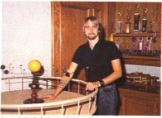
Richard Garriott with an orrery, one of the many toys he kept at the recently purchased Austin house he called Britannia Manor.
Origin was in a very awkward spot. Having frittered away a full year recovering from the strain of making the previous Ultima, trying to decide what the next Ultima should be, and traveling down the technological cul de sac that was now the Apple II, they simply had to have Ultima VI finished — meaning designed and coded from nothing on an entirely new platform — within one more year if the company was to survive. Origin had never had more than a modestly successful game that wasn’t an Ultima; the only way their business model worked was if Richard Garriott every couple of years delivered a groundbreaking new entry in their one and only popular franchise and it sold 200,000 copies or more.
John Miles, lacking a strong background in MS-DOS programming and the C language in which all future Ultimas would be coded, was transferred off the team to get himself up to speed and, soon enough, to work on middleware libraries and tools for the company’s other programmers. Replacing him on the project in Origin’s new offices in Austin, Texas, were Herman Miller and Cheryl Chen, a pair of refugees from the old offices in New Hampshire, which had finally been shuttered completely in January of 1989. It was a big step for both of them to go from coding what until quite recently had been afterthought MS-DOS versions of Origin’s games to taking a place at the center of the most critical project in the company. Fortunately, both would prove more than up to the task.
Just as Garriott had quickly learned to like the efficiency of not being personally responsible for implementing every single aspect of Ultima V, he soon found plenty to like about the switch to MS-DOS. The new platform had four times the memory of the Apple II machines Origin had been targeting before, along with (comparatively) blazing-fast processors, hard drives, 256-color VGA graphics, sound cards, and mice. A series that had been threatening to burst the seams of the Apple II now had room to roam again. For the first time with Ultima VI, time rather than technology was the primary restraint on Garriott’s ambitions.
But arguably the real savior of Ultima VI was not a new computing platform but a new Origin employee: one Warren Spector, who would go on to join Garriott and Chris Roberts — much more on him in a future article — as one of the three world-famous game designers to come out of the little collective known as Origin Systems. Born in 1955 in New York City, Spector had originally imagined for himself a life in academia as a film scholar. After earning his Master’s from the University of Texas in 1980, he’d spent the next few years working toward his PhD and teaching undergraduate classes. But he had also discovered tabletop gaming at university, from Avalon Hill war games to Dungeons & Dragons. When a job as a research archivist which he’d thought would be his ticket to the academic big leagues unexpectedly ended after just a few months, he wound up as an editor and eventually a full-fledged game designer at Steve Jackson Games, maker of card games, board games, and RPGs, and a mainstay of Austin gaming circles. It was through Steve Jackson, like Richard Garriott a dedicated member of Austin’s local branch of the Society for Creative Anachronism, that Spector first became friendly with the gang at Origin; he also discovered Ultima IV, a game that had a profound effect on him. He left Austin in March of 1987 for a sojourn in Wisconsin with TSR, the makers of Dungeons & Dragons, but, jonesing for the warm weather and good barbecue of the city that had become his adopted hometown, he applied for a job with Origin two years later. Whatever role his acquaintance with Richard Garriott and some of the other folks there played in getting him an interview, it certainly didn’t get him a job all by itself; Spector claims that Dallas Snell, Robert Garriott’s right-hand man running the business side of the operation, grilled him for an incredible nine hours before judging him worthy of employment. (“May you never have to live through something like this just to get a job,” he wishes for all and sundry.) Starting work at Origin on April 12, 1989, he was given the role of producer on Ultima VI, the high man on the project totem pole excepting only Richard Garriott himself.
Age 33 and married, Spector was one of the oldest people employed by this very young company; he realized to his shock shortly after his arrival that he had magazine subscriptions older than Origin’s up-and-coming star Chris Roberts. A certain wisdom born of his age, along with a certain cultural literacy born of all those years spent in university circles, would serve Origin well in the seven years he would remain there. Coming into a company full of young men who had grand dreams of, as their company’s tagline would have it, “creating worlds,” but whose cultural reference points didn’t usually reach much beyond Lord of the Rings and Star Wars, Spector was able to articulate Origin’s ambitions for interactive storytelling in a way that most of the others could not, and in time would use his growing influence to convince management of the need for a real, professional writing team to realize those ambitions. In the shorter term — i.e., in the term of the Ultima VI project — he served as some badly needed adult supervision, systematizing the process of development by providing everyone on his team with clear responsibilities and by providing the project as a whole with the when and what of clear milestone goals. The project was so far behind that everyone involved could look forward to almost a year of solid crunch time as it was; Spector figured there was no point in making things even harder by letting chaos reign.
On the Ultima V project, it had been Dallas Snell who had filled the role of producer, but Snell, while an adept organizer and administrator, wasn’t a game designer or a creative force by disposition. Spector, though, proved himself capable of tackling the Ultima VI project from both sides, hammering out concrete design documents from the sometimes abstracted musings of Richard Garriott, then coming up with clear plans to bring them to fruition. In the end, the role he would play in the creation of Ultima VI was as important as that of Garriott himself. Having learned to share the technical burden with Ultima V — or by now to pass it off entirely; he never learned C and would never write a single line of code for any commercial game ever again — Garriott was now learning to share the creative burden as well, another necessary trade-off if his ever greater ambitions for his games were to be realized.
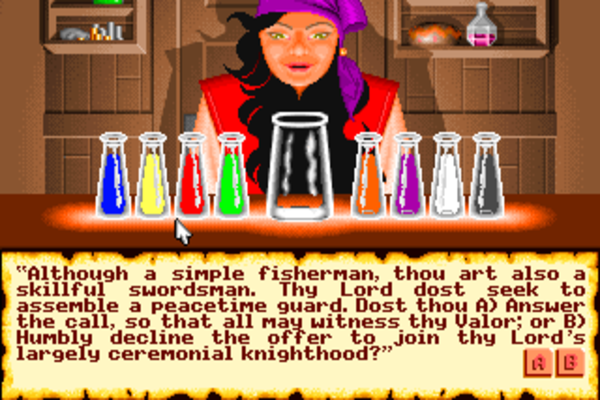
If you choose not to import an Ultima V character into Ultima VI, you go through the old Ultima IV personality test, complete with gypsy soothsayer, to come up with your personal version of the Avatar. By this time, however, with the series getting increasingly plot-heavy and the Avatar’s personality ever more fleshed-out within the games, the personality test was starting to feel a little pointless. Blogger Chet Bolingbroke, the “CRPG Addict,” cogently captured the problems inherent in insisting that all of these disparate Ultima games had the same hero:
Then there’s the Avatar. Not only is it unnecessary to make him the hero of the first three games, as if the Sosarians and Britannians are so inept they always need outside help to solve their problems, but I honestly think the series should have abandoned the concept after Ultima IV. In that game, it worked perfectly. The creators were making a meta-commentary on the very nature of playing role-playing games. The Avatar was clearly meant to be the player himself or herself, warped into the land through the “moongate” of his or her computer screen, represented as a literal avatar in the game window. Ultima IV was a game that invited the player to act in a way that was more courageous, more virtuous, more adventurous than in the real world. At the end of the game, when you’re manifestly returned to your real life, you’re invited to “live as an example to thine own people”–to apply the lesson of the seven virtues to the real world. It was brilliant. They should have left it alone.
Already in Ultima V, though, they were weakening the concept. In that game, the Avatar is clearly not you, but some guy who lives alone in his single-family house of a precise layout. But fine, you rationalize, all that is just a metaphor for where you actually do live. By Ultima VI, you have some weird picture of a pole-dancing centaur girl on your wall, you’re inescapably a white male with long brown hair.
Following what had always been Richard Garriott’s standard approach to making an Ultima, the Ultima VI team concentrated on building their technology and then building a world around it before adding a plot or otherwise trying to turn it all into a real game with a distinct goal. Garriott and others at Origin would always name Times of Lore, a Commodore 64 action/CRPG hybrid written by Chris Roberts and published by Origin in 1988, as the main influence on the new Ultima VI interface, the most radically overhauled version of same ever to appear in an Ultima title. That said, it should be noted that Times of Lore itself lifted many or most of its own innovations from The Faery Tale Adventure, David Joiner’s deeply flawed but beautiful and oddly compelling Commodore Amiga action/CRPG of 1987. By way of completing the chain, much of Times of Lore‘s interface was imported wholesale into Ultima VI; even many of the onscreen icons looked exactly the same. The entire game could now be controlled, if the player liked, with a mouse, with all of the keyed commands duplicated as onscreen buttons; this forced Origin to reduce the “alphabet soup” that had been previous Ultima interfaces, which by Ultima V had used every letter in the alphabet plus some additional key combinations, to ten buttons, with the generic “use” as the workhorse taking the place of a multitude of specifics.
Another influence, one which Origin was for obvious reasons less eager to publicly acknowledge than that of Times of Lore, was FTL’s landmark 1987 CRPG Dungeon Master, a game whose influence on its industry can hardly be overstated. John Miles remembers lots of people at Origin scrambling for time on the company’s single Atari ST in order to play it soon after its release. Garriott himself has acknowledged being “ecstatic” for his first few hours playing it at all the “neat new things I could do.” Origin co-opted Dungeon Master‘s graphical approach to inventory management, including the soon-to-be ubiquitous “paper doll” method of showing what characters were wearing and carrying.
Taking a cue from theories about good interface design dating back to Xerox PARC and Apple’s Macintosh design team, The Faery Tale Adventure, Times of Lore, and Dungeon Master had all abandoned “modes”: different interfaces — in a sense entirely different programs — which take over as the player navigates through the game. The Ultima series, like most 1980s CRPGs, had heretofore been full of these modes. There was one mode for wilderness travel; another for exploring cities, towns, and castles; another, switching from a third-person overhead view to a first-person view like Wizardry (or, for that matter, Dungeon Master), for dungeon delving. And when a fight began in any of these modes, the game switched to yet another mode for resolving the combat.
Ultima VI collapsed all of these modes down into a single unified experience. Wilderness, cities, and dungeons now all appeared on a single contiguous map on which combat also occurred, alongside everything else possible in the game; Ultima‘s traditionally first-person dungeons were now displayed using an overhead view like the rest of the game. From the standpoint of realism, this was a huge step back; speaking in strictly realistic terms, either the previously immense continent of Britannia must now be about the size of a small suburb or the Avatar and everyone else there must now be giants, building houses that sprawled over dozens of square miles. But, as we’ve had plenty of occasion to discuss in previous articles, the most realistic game design doesn’t always make the best game design. From the standpoint of creating an immersive, consistent experience for the player, the new interface was a huge step forward.
As the world of Britannia had grown more complex, the need to give the player a unified window into it had grown to match, in ways that were perhaps more obvious to the designers than they might have been to the players. The differences between the first-person view used for dungeon delving and the third-person view used for everything else had become a particular pain. Richard Garriott had this to say about the problems that were already dogging him when creating Ultima V, and the changes he thus chose to make in Ultima VI:
Everything that you can pick up and use [in Ultima V] has to be able to function in 3D [i.e., first person] and also in 2D [third person]. That meant I had to either restrict the set of things players can use to ones that I know I can make work in 3D or 2D, or make them sometimes work in 2D but not always work in 3D or vice versa, or they will do different things in one versus the other. None of those are consistent, and since I’m trying to create an holistic world, I got rid of the 3D dungeons.
Ultima V had introduced the concept of a “living world” full of interactive everyday objects, along with characters who went about their business during the course of the day, living lives of their own. Ultima VI would build on that template. The world was still constructed, jigsaw-like, from piles of tile graphics, an approach dating all the way back to Ultima I. Whereas that game had offered 16 tiles, however, Ultima VI offered 2048, all or almost all of them drawn by Origin’s most stalwart artist, Denis Loubet, whose association with Richard Garriott stretched all the way back to drawing the box art for the California Pacific release of Akalabeth. Included among these building blocks were animated tiles of several frames — so that, for instance, a water wheel could actually spin inside a mill and flames in a fireplace could flicker. Dynamic, directional lighting of the whole scene was made possible by the 256 colors of VGA. While Ultima V had already had a day-to-night cycle, in Ultima VI the sun actually rose in the east and set in the west, and torches and other light sources cast a realistic glow onto their surroundings.
In a clear signal of where the series’s priorities now lay, other traditional aspects of CRPGs were scaled back, moving the series further from its roots in tabletop Dungeons & Dragons. Combat, having gotten as complicated and tactical as it ever would with Ultima V, was simplified, with a new “auto-combat” mode included for those who didn’t want to muck with it at all; the last vestiges of distinct character races and classes were removed; ability scores were boiled down to just three numbers for Strength, Dexterity, and Intelligence. The need to mix reagents in order to cast spells, one of the most mind-numbingly boring aspects of a series that had always made you do far too many boring things, was finally dispensed with; I can’t help but imagine legions of veteran Ultima players breathing a sigh of relief when they read in the manual that “the preparation of a spell’s reagents is performed at the moment of spellcasting.” The dodgy parser-based conversation system of the last couple of games, which had required you to try typing in every noun mentioned by your interlocutor on the off chance that it would elicit vital further information, was made vastly less painful by the simple expedient of highlighting in the text those subjects into which you could inquire further.
Inevitably, these changes didn’t always sit well with purists, then or now. Given the decreasing interest in statistics and combat evinced by the Ultima series as time went on, as well as the increasing emphasis on what we might call solving the puzzles of its ever more intricate worlds, some have accused later installments of the series of being gussied-up adventure games in CRPG clothing; “the last real Ultima was Ultima V” isn’t a hard sentiment to find from a vocal minority on the modern Internet. What gives the lie to that assertion is the depth of the world modeling, which makes these later Ultimas flexible in ways that adventure games aren’t. Everything found in the world has, at a minimum, a size, a weight, and a strength. Say, then, that you’re stymied by a locked door. There might be a set-piece solution for the problem in the form of a key you can find, steal, or trade for, but it’s probably also possible to beat the door down with a sufficiently big stick and a sufficiently strong character, or if all else fails to blast it open with a barrel of dynamite. Thus your problems can almost never become insurmountable, even if you screw up somewhere else. Very few other games from Ultima VI‘s day made any serious attempt to venture down this path. Infocom’s Beyond Zork tried, somewhat halfheartedly, and largely failed at it; Sierra’s Hero’s Quest was much more successful at it, but on nothing like the scale of an Ultima. Tellingly, almost all of the “alternate solutions” to Ultima VI‘s puzzles emerge organically from the simulation, with no designer input whatsoever. Richard Garriott:
I start by building a world which you can interact with as naturally as possible. As long as I have the world acting naturally, if I build a world that is prolific enough, that has as many different kinds of natural ways to act and react as possible, like the real world does, then I can design a scenario for which I know the end goal of the story. But exactly whether I have to use a key to unlock the door, or whether it’s an axe I pick up to chop down the door, is largely irrelevant.
The complexity of the world model was such that Ultima VI became the first installment that would let the player get a job to earn money in lieu of the standard CRPG approach of killing monsters and taking their loot. You can buy a sack of grain from a local farmer, take the grain to a mill and grind it into flour, then sell the flour to a baker — or sneak into his bakery at night to bake your own bread using his oven. Even by the standards of today, the living world inside Ultima VI is a remarkable achievement — not to mention a godsend to those of us bored with killing monsters; you can be very successful in Ultima VI whilst doing very little killing at all.
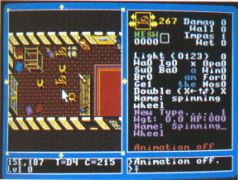
A rare glimpse of Origin’s in-house Ultima VI world editor, which looks surprisingly similar to the game itself.
Plot spoilers begin!
It wasn’t until October of 1989, just five months before the game absolutely, positively had to ship, that Richard Garriott turned his attention to the Avatar’s reason for being in Britannia this time around. The core idea behind the plot came to him during a night out on Austin’s Sixth Street: he decided he wanted to pitch the Avatar into a holy war against enemies who, in classically subversive Ultima fashion, turn out not to be evil at all. In two or three weeks spent locked together alone in a room, subsisting on takeout Chinese food, Richard Garriott and Warren Spector created the “game” part of Ultima VI from this seed, with Spector writing it all down in a soy-sauce-bespattered notebook. Here Spector proved himself more invaluable than ever. He could corral Garriott’s sometimes unruly thoughts into a coherent plan on the page, whilst offering plenty of contributions of his own. And he, almost uniquely among his peers at Origin, commanded enough of Garriott’s respect — was enough of a creative force in his own right — that he could rein in the bad and/or overambitious ideas that in previous Ultimas would have had to be attempted and proved impractical to their originator. Given the compressed development cycle, this contribution too was vital. Spector:
An insanely complicated process, plotting an Ultima. I’ve written a novel, I’ve written [tabletop] role-playing games, I’ve written board games, and I’ve never seen a process this complicated. The interactions among all the characters — there are hundreds of people in Britannia now, hundreds of them. Not only that, but there are hundreds of places and people that players expect to see because they appeared in five earlier Ultimas.
Everybody in the realm ended up being a crucial link in a chain that adds up to this immense, huge, wonderful, colossal world. It was a remarkably complicated process, and that notebook was the key to keeping it all under control.
The chain of information you follow in Ultima VI is, it must be said, far clearer than in any of the previous games. Solving this one must still be a matter of methodically talking to everyone and assembling a notebook full of clues — i.e., of essentially recreating Garriott and Spector’s design notebook — but there are no outrageous intuitive leaps required this time out, nor any vital clues hidden in outrageously out-of-the-way locations. For the first time since Ultima I, a reasonable person can reasonably be expected to solve this Ultima without turning it into a major life commitment. The difference is apparent literally from your first moments in the game: whereas Ultima V dumps you into a hut in the middle of the wilderness — you don’t even know where in the wilderness — with no direction whatsoever, Ultima VI starts you in Lord British’s castle, and your first conversation with him immediately provides you with your first leads to run down. From that point forward, you’ll never be at a total loss for what to do next as long as you do your due diligence in the form of careful note-taking. Again, I have to attribute much of this welcome new spirit of accessibility and solubility to the influence of Warren Spector.
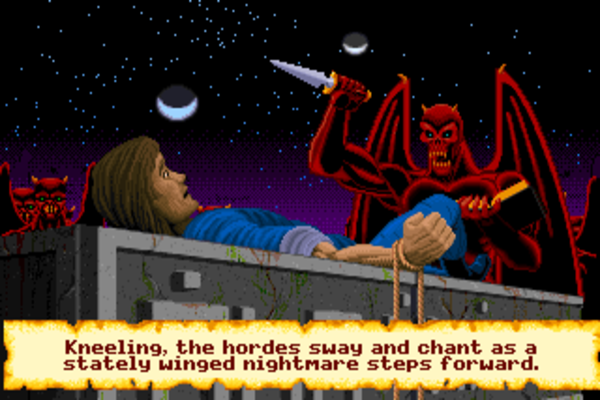
Ultima VI pushes the “Gargoyles are evil!” angle hard early on, going so far as to have the seemingly demonic beasts nearly sacrifice you to whatever dark gods they worship. This of course only makes the big plot twist, when it arrives, all the more shocking.
At the beginning of Ultima VI, the Avatar — i.e., you — is called back to Britannia from his homeworld of Earth yet again by the remarkably inept monarch Lord British to deal with yet another crisis which threatens his land. Hordes of terrifyingly demonic-looking Gargoyles are pouring out of fissures which have opened up in the ground everywhere and making savage war upon the land. They’ve seized and desecrated the eight Shrines of Virtue, and are trying to get their hands on the Codex of Ultimate Wisdom, the greatest symbol of your achievements in Ultima IV.
But, in keeping with the shades of gray the series had begun to layer over the Virtues with Ultima V, nothing is quite as it seems. In the course of the game, you discover that the Gargoyles have good reason to hate and fear humans in general and you the Avatar in particular, even if those reasons are more reflective of carelessness and ignorance on the part of you and Lord British’s peoples than they are of malice. To make matters worse, the Gargoyles are acting upon a religious prophecy — conventional religion tends to take a beating in Ultima games — and have come to see the Avatar as nothing less than the Antichrist in their own version of the Book of Revelation. As your understanding of their plight grows, your goal shifts from that of ridding the land of the Gargoyle scourge by violent means to that of walking them back from attributing everything to a foreordained prophecy and coming to a peaceful accommodation with them.
Ultima VI‘s subtitle, chosen very late in the development process, is as subtly subversive as the rest of the plot. Not until very near the end of the game do you realize that The False Prophet is in fact you, the Avatar. As the old cliché says, there are two sides to every story. Sadly, the big plot twist was already spoiled by Richard Garriott in interviews before Ultima VI was even released, so vanishingly few players have ever gotten to experience its impact cold.
When discussing the story of Ultima VI, we shouldn’t ignore the real-world events that were showing up on the nightly news while Garriott and Spector were writing it. Mikhail Gorbachev had just made the impossibly brave decision to voluntarily dissolve the Soviet empire and let its vassal states go their own way, and just like that the Cold War had ended, not in the nuclear apocalypse so many had anticipated as its only possible end game but rather in the most blessed of all anticlimaxes in human history. For the first time in a generation, East was truly meeting West again, and each side was discovering that the other wasn’t nearly as demonic as they had been raised to believe. On November 10, 1989, just as Garriott and Spector were finishing their design notebook, an irresistible tide of mostly young people burst through Berlin’s forbidding Checkpoint Charlie to greet their counterparts on the other side, as befuddled guards, the last remnants of the old order, looked on and wondered what to do. It was a time of extraordinary change and hope, and the message of Ultima VI resonated with the strains of history.
Plot spoilers end.
When Garriott and Spector emerged from their self-imposed quarantine, the first person to whom they gave their notebook was an eccentric character with strong furry tendencies who had been born as David Shapiro, but who was known to one and all at Origin as Dr. Cat. Dr. Cat had been friends with Richard Garriott for almost as long as Denis Loubet, having first worked at Origin for a while when it was still being run out of Richard’s parents’ garage in suburban Houston. A programmer by trade — he had done the Commodore 64 port of Ultima V — Dr. Cat was given the de facto role of head writer for Ultima VI, apparently because he wasn’t terribly busy with anything else at the time. Over the next several months, he wrote most of the dialog for most of the many characters the Avatar would need to speak with in order to finish the game, parceling the remainder of the work out among a grab bag of other programmers and artists, whoever had a few hours or days to spare.
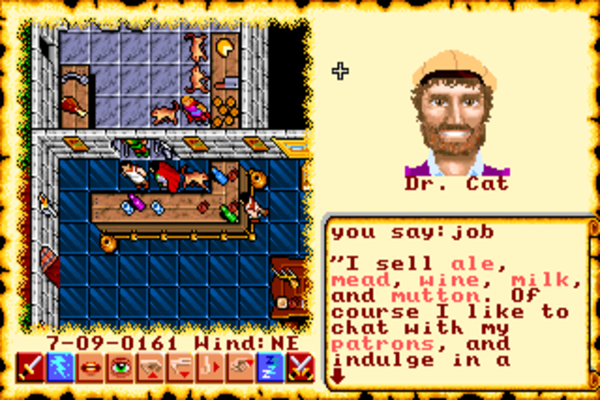
Origin Systems was still populating the games with jokey cameos drawn from Richard Garriott’s friends, colleagues, and family as late as Ultima VI. Thankfully, this along with other aspects of the “programmer text” syndrome would finally end with the next installment in the series, for which a real professional writing team would come aboard. More positively, do note the keyword highlighting in the screenshot above, which spared players untold hours of aggravating noun-guessing.
Everyone at Origin felt the pressure by now, but no one carried a greater weight on his slim shoulders than Richard Garriott. If Ultima VI flopped, or even just wasn’t a major hit, that was that for Origin Systems. For all that he loved to play His Unflappable Majesty Lord British in public, Garriott was hardly immune to the pressure of having dozens of livelihoods dependent on what was at the end of the day, no matter how much help he got from Warren Spector or anyone else, his game. His stress tended to go straight to his stomach. He remembers being in “constant pain”; sometimes he’d just “curl up in the corner.” Having stopped shaving or bathing regularly, strung out on caffeine and junk food, he looked more like a homeless man than a star game designer — much less a regal monarch — by the time Ultima VI hit the homestretch. On the evening of February 9, 1990, with the project now in the final frenzy of testing, bug-swatting, and final-touch-adding, he left Origin’s offices to talk to some colleagues having a smoke just outside. When he opened the security door to return, a piece of the door’s apparatus — in fact, an eight-pound chunk of steel — fell off and smacked him in the head, opening up an ugly gash and knocking him out cold. His panicked colleagues, who at first thought he might be dead, rushed him to the emergency room. Once he had had his head stitched up, he set back to work. What else was there to do?
Ultima VI shipped on time in March of 1990, two years almost to the day after Ultima V, and Richard Garriott’s fears (and stomach cramps) were soon put to rest; it became yet another 200,000-plus-selling hit. Reviews were uniformly favorable if not always ecstatic; it would take Ultima fans, traditionalists that so many of them were, a while to come to terms with the radically overhauled interface that made this Ultima look so different from the Ultimas of yore. Not helping things were the welter of bugs, some of them of the potentially showstopping variety, that the game shipped with (in years to come Origin would become almost as famous for their bugs as for their ambitious virtual world-building). In time, most if not all old-school Ultima fans were comforted as they settled in and realized that at bottom you tackled this one pretty much like all the others, trekking around Britannia talking to people and writing down the clues they revealed until you put together all the pieces of the puzzle. Meanwhile Origin gradually fixed the worst of the bugs through a series of patch disks which they shipped to retailers to pass on to their customers, or to said customers directly if they asked for them. Still, both processes did take some time, and the reaction to this latest Ultima was undeniably a bit muted — a bit conflicted, one might even say — in comparison to the last few games. It perhaps wasn’t quite clear yet where or if the Ultima series fit on these newer computers in this new decade.
Both the muted critical reaction and that sense of uncertainty surrounding the game have to some extent persisted to this day. Firmly ensconced though it apparently is in the middle of the classic run of Ultimas, from Ultima IV through Ultima VII, that form the bedrock of the series’s legacy, Ultima VI is the least cherished of that cherished group today, the least likely to be named as the favorite of any random fan. It lacks the pithy justification for its existence that all of the others can boast. Ultima IV was the great leap forward, the game that dared to posit that a CRPG could be about more than leveling up and collecting loot. Ultima V was the necessary response to its predecessor’s unfettered idealism; the two games together can be seen to form a dialog on ethics in the public and private spheres. And, later, Ultima VII would be the pinnacle of the series in terms not only of technology but also, and even more importantly, in terms of narrative and thematic sophistication. But where does Ultima VI stand in this group? Its plea for understanding rather than extermination is as important and well-taken today as it’s ever been, yet its theme doesn’t follow as naturally from Ultima V as that game’s had from Ultima IV, nor is it executed with the same sophistication we would see in Ultima VII. Where Ultima VI stands, then, would seem to be on a somewhat uncertain no man’s land.
Indeed, it’s hard not to see Ultima VI first and foremost as a transitional work. On the surface, that’s a distinction without a difference; every Ultima, being part of a series that was perhaps more than any other in the history of gaming always in the process of becoming, is a bridge between what had come before and what would come next. Yet in the case of Ultima VI the tautology feels somehow uniquely true. The graphical interface, huge leap though it is over the old alphabet soup, isn’t quite there yet in terms of usability. It still lacks a drag-and-drop capability, for instance, to make inventory management and many other tasks truly intuitive, while the cluttered onscreen display combines vestiges of the old, such as a scrolling textual “command console,” with this still imperfect implementation of the new. The prettier, more detailed window on the world is welcome, but winds up giving such a zoomed-in view in the half of a screen allocated to it that it’s hard to orient yourself. The highlighted keywords in the conversation engine are also welcome, but are constantly scrolling off the screen, forcing you to either lawnmower through the same conversations again and again to be sure not to miss any of them or to jot them down on paper as they appear. There’s vastly more text in Ultima VI than in any of its predecessors, but perhaps the kindest thing to be said about Dr. Cat as a writer is that he’s a pretty good programmer. All of these things would be fixed in Ultima VII, a game — or rather games; there were actually two of them, for reasons we’ll get to when the time comes — that succeeded in becoming everything Ultima VI had wanted to be. To use the old playground insult, everything Ultima VI can do Ultima VII can do better. One thing I can say, however, is that the place the series was going would prove so extraordinary that it feels more than acceptable to me to have used Ultima VI as a way station en route.
But in the even more immediate future for Origin Systems was another rather extraordinary development. This company that the rest of the industry jokingly referred to as Ultima Systems would release the same year as Ultima VI a game that would blow up even bigger than this latest entry in the series that had always been their raison d’être. I’ll tell that improbable story soon, after a little detour into some nuts and bolts of computer technology that were becoming very important — and nowhere more so than at Origin — as the 1990s began.
(Sources: the books Dungeons and Dreamers: The Rise of Computer Game Culture from Geek to Chic by Brad King and John Borland, The Official Book of Ultima, Second Edition by Shay Addams, and Ultima: The Avatar Adventures by Rusel DeMaria and Caroline Spector; ACE of April 1990; Questbusters of November 1989, January 1990, March 1990, and April 1990; Dragon of July 1987; Computer Gaming World of March 1990 and June 1990; Origin’s in-house newsletter Point of Origin of August 7 1991. Online sources include Matt Barton’s interviews with Dr. Cat and Warren Spector’s farewell letter from the Wing Commander Combat Information Center‘s document archive. Last but far from least, my thanks to John Miles for corresponding with me via email about his time at Origin, and my thanks to Casey Muratori for putting me in touch with him.
Ultima VI is available for purchase from GOG.com in a package that also includes Ultima IV and Ultima V.)

